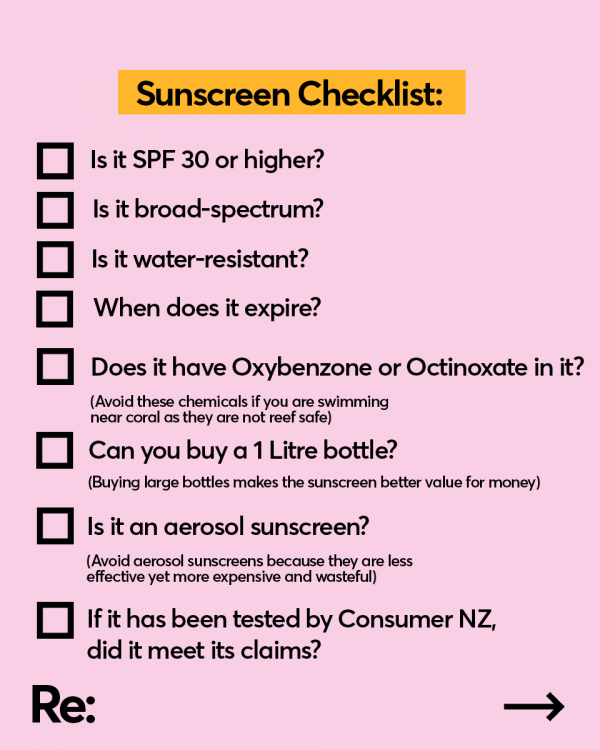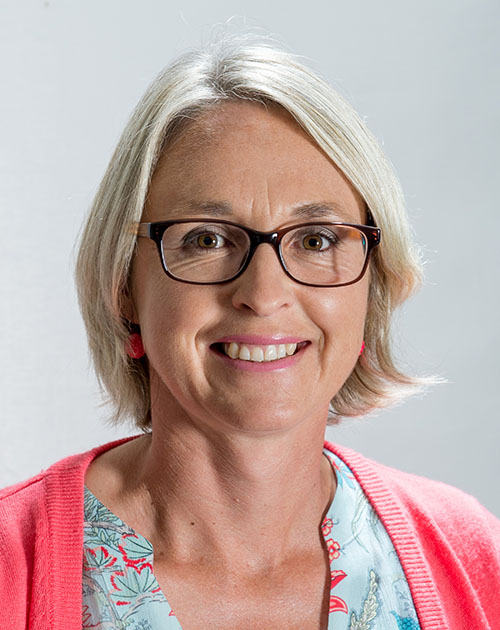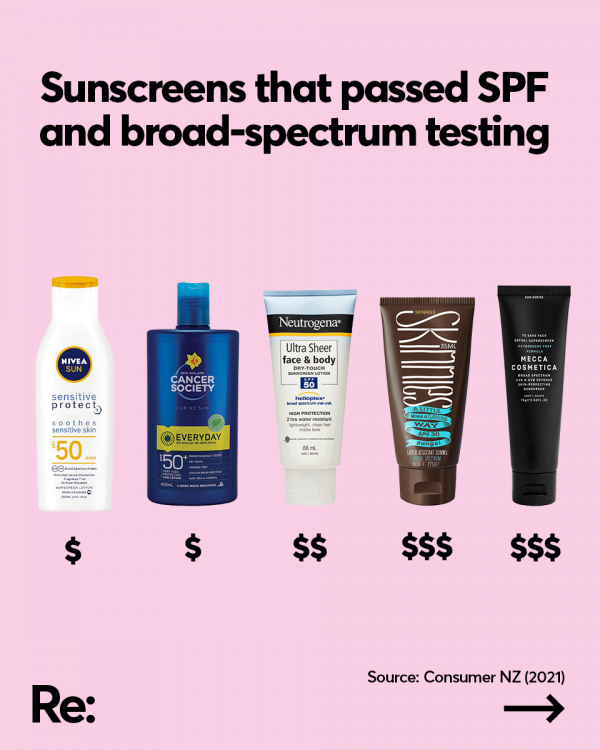This story was republished for Re:'s Fashion Week on August 28, 2022.
Update (31/03/2022):
An international study has found New Zealand had the highest melanoma death rate in the world in 2020.
Alongside Australia, we also had the highest number of melanoma cases.
Here’s a refresher of what to look for when you fork out for your next bottle of sunscreen.
But remember, sunscreen is only one part of your protection from skin cancer - seeking shade, covering up and avoiding the sun during peak hours where possible is just as important.
Also don’t forget it’s vital to wear sunscreen all year round, not just in summer.
We know we need sunscreen, but half of the time we don’t really know what we are looking for.
Usually the price, the size of the bottle or the feel of the sunscreen are the biggest things people care about.
But it turns out there’s a whole lot more to it.
Re: has put together a checklist of things to look out for when you fork out for your next bottle of sunscreen.

SPF Ratings
Firstly, what do SPF ratings actually mean? And what is the difference between SPF 30 and SPF 50? Is SPF 30 enough?
SPF stands for Sun Protection Factor.
An SPF rating tells you how long you can stay out in the sun without getting burnt while wearing sunscreen.
For example, if a person who isn’t wearing sunscreen takes 15 minutes to burn then applying SPF 10 will, in theory, take you 10 times longer to burn — so 2.5 hours.
But all of these calculations start to sound a bit ridiculous when it comes to SPF 30 or SPF 50.
No sunscreen allows you to stay in the sun for 7.5 hours without being burnt.
So if you are tossing up between SPF 30 and SPF 50, what do you choose?

Belinda Castles // Photo Supplied: Consumer New Zealand
Belinda Castles, Consumer New Zealand’s head sunscreen researcher and test lead, says it’s important to remember that SPF 15 is not double the strength of SPF 30.
“But SPF 30 does block out more of the sun’s UV rays,” she says.
How it works is SPF 15 lets 1/15 UVB rays hit your skin, meaning 14/15 are blocked. That means SPF 15 blocks 93 percent of all UVB rays
SPF 30 lets 1/30 UVB rays hit your skin, meaning 29/30 are blocked, so SPF 30 blocks 97 percent of UVB rays. SPF 50 then means 98 percent of UVB rays are blocked.
To sum up, there’s not much difference between SPF 30 and SPF 50 at all.
That’s why Castles, as well as Cancer Society NZ, recommend you use water-resistant and broad-spectrum protection of at least SPF 30 or higher.
“The most important thing is how you use it,” Castles says.
“Irrespective of what SPF it is, you need to reapply every two hours when you are outside,” she says.
“Apply at least 20 minutes before you go outside and reapply after going swimming or drying yourself with a towel. And remember you can’t just rely on sunscreen for protection, wear a hat, sunglasses, cover up and seek shade when you can as well.”
It is also recommended people wear sunscreen everyday, all-year round as skin damage from UV rays doesn’t just happen on sunny days in summer.
What does broad-spectrum mean?
The sun’s UV rays consist of UVA and UVB.
Castles says UVA penetrates deep into the skin and causes skin ageing and long-term damage.
Whereas UVB affects the skin’s top layer, causing sunburn and also long-term damage.
Both UVA and UVB can cause skin cancer.
“Broad-spectrum sunscreen filters out both UVA and UVB rays, so it’s important to look out for this,” Castles says.
In Consumer NZ’s 2021 sunscreen tests, it found popular sunscreen brands Banana Boat Daily Protect Sunscreen Lotion SPF 50+ and Le Tan Coconut Lotion SPF 50 did not meet their SPF claims.
Banana Boat was really SPF 40.4 and Le Tan was SPF 42.7, which is still high protection.
For the second year running, natural sunscreen brands Natural Instinct Invisible Natural Sunscreen SPF 30 and Sukin Suncare Sheer Touch Facial Sunscreen Untinted SPF 30 only provided moderate protection, not the high protection they claimed.
Sukin and Banana Boat also failed to meet broad-spectrum requirements.
The popular sunscreen brands below met both their SPF and broad spectrum claims.

Castles says sunscreen in New Zealand can be sold without meeting its claims because our sunscreen market is unregulated.
“It’s only voluntary for sunscreen brands to meet Australian or European standards. So that means that anyone can make a sunscreen and sell it without having it tested. It's a pretty ridiculous situation really.”
There is currently a bill going through parliament that would make sunscreen regulation mandatory in New Zealand.
Chemical sunscreen vs. physical sunscreens
Chemical sunscreens are formulas that use chemical filters to protect the skin from UV rays. The chemicals act like a sponge, absorbing UV before it can reach your skin.
Physical (or mineral/natural) sunscreens sit on your skin and physically block UV with natural ingredients like titanium dioxide or zinc oxide. That’s why they are sometimes called ‘sunblocks’.
“The active ingredients in mineral sunscreens like zinc oxide and titanium work as they reflect or scatter the UV rays away from your skin,” Castles says.
“So chemical and physical sunscreens work quite differently.”
The most widely used sunscreens like Nivea or Cancer Society are chemical sunscreens because the texture of the formula makes them easily spreadable and absorb quickly.
They are also lightweight and have an invisible finish which makes them easy for daily wear.
However, chemical sunscreens can irritate sensitive skin or acne-prone skin.
That’s why some people use physical sunscreens because they are more gentle and sit on your skin, so they are less likely to clog your pores
Physical sunscreens are also immediately effective against the sun's rays, while most chemical sunscreens take about 20 to 30 minutes to sink into your skin and be effective.
Chemical sunscreens also need to be applied more regularly than mineral sunscreens.
While some mineral sunscreens leave a white cast on your skin, Castles says nowadays companies use a form of nanoparticles which are tiny molecules that make sunscreen transparent, although they may be a little harder to rub in than chemical formulas.
Avoid aerosol sunscreens
Consumer New Zealand does not include aerosol sunscreen in its tests.
Castles says this is because aerosol cans are more expensive, wasteful and less effective.
“Aerosols may be convenient to use, but the way the formula is sprayed on often means not enough is applied and it doesn’t sink properly into your skin. This can mean more chemicals are washing off into the ocean which can cause damage to sea life and leave you less protected.”
“And they are expensive”, Castles says.
The Australian consumer organisation Choice estimates only about 40 to 60 percent of an aerosol can is sunscreen – the rest are propellants.
“That’s why you go through it so quickly. They are definitely not the best option.”
Reef safety
In recent years, reef safety has become yet another thing to consider when buying sunscreen.
While research in this area is limited, some studies suggest oxybenzone and octinoxate can cause harm to coral reefs.
However, these studies have been criticised because the results were collected through controlled lab experiments and do not necessarily reflect what happens in the ocean.
So what does reef-safety actually mean? Read more about it here.
More stories: